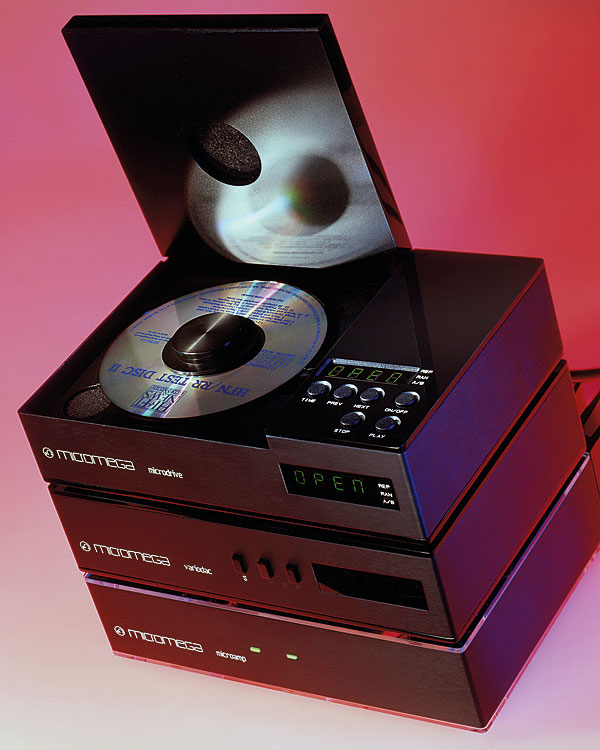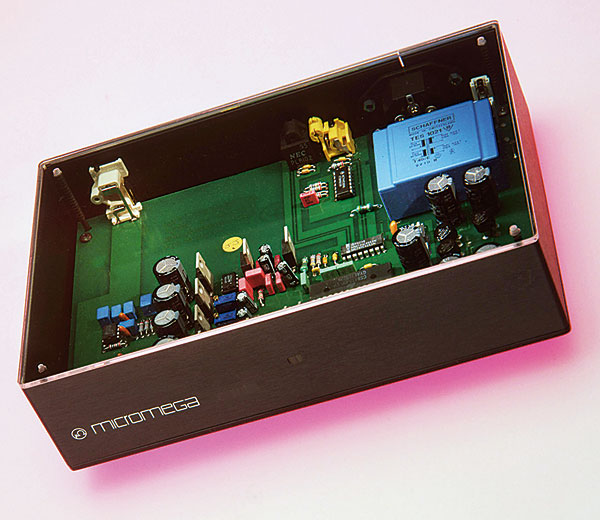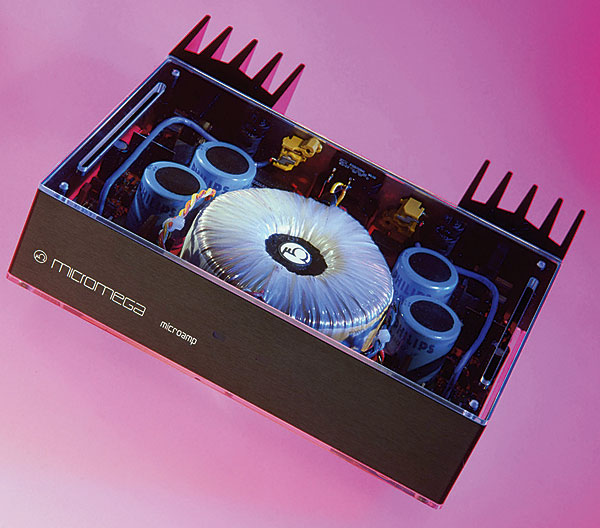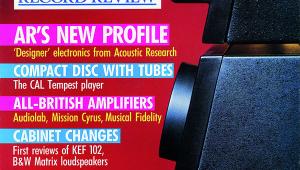Micros Can Be Mega Page 2
![]() Reference Group
Reference Group
For this report two grades of speaker were used, namely the Epos ES-11 and the Spendor SP2-2, the latter making the best of the amplifier's output. Yes, it did work well with the Quad Electrostatic, but could not play loudly enough to justify its use. Reference electronics included Micromega's own Duo BS decoder, the Duo and Meridian 200 transports and the Musical Fidelity A1000 integrated amplifier.
The Microdrive is not particularly well isolated and on my floor it would mistrack occasionally when someone walked out of the room. A dedicated turntable table helped matters here and also improved the sound. Its siting needs some consideration. The Variodac was even-tempered and its functions certainly operated well.

Viewed as a system, the review group totals £2100 plus loudspeakers and cables, and it received a mixed reception. On the positive side, it coped with all genres of music with an easy grace, never sounding aggressive or obtrusive. Tonal balances were consistently neutral, and the sound was also free from hardness and had no obvious coloration or distortion – for example, treble roughness or grain. These are all important points.
Conversely, while the overall standard was above average, in context it did not greatly draw the listener's attention. Certainly competent as regards factors such as clarity, stage depth and focus, it was rated just average for dynamics and rhythm. In this price group, Micromega's own Duo BS clearly demonstrated just how vital and communicative this technology can sound, effortlessly showing its paces in conjunction with the Musical Fidelity A1000 integrated amplifier.
The answer was to split up the Micro system and substitute for each component in turn. First, the Microdrive was replaced by the Meridian 200. The latter's high rating was confirmed immediately and showed the Microdrive to be the dominant restraining factor in the system sound. With the '200 in its place the soundstage was substantially clearer, deeper, wider and better focused. There was an uplift in dynamics while both bass timing and attack were improved, and this comparison showed that the Microdrive had not yet reached the required standard.

Fine Fare
Next, the Duo BS was connected to the Variodac analogue input, with the Meridian 200 transport. Here, the Variodac gave a good account of itself and while the Duo was clearly better, on my listening test scoring system the 'DAC' rating for the Variodac was fine. In practice, its on-board volume control will give it an additional advantage. The Variodac has a performance in the 'good' to 'very good' range for stereo soundstage, clarity, tonality and also has above average dynamics and rhythm. Equally important was the approval gained for the analogue line amplifier section, since those fine results were achieved with this being present in the replay chain.
As for the Microamp, this was found to be respectable if not particularly outstanding. Certainly, it did not compromise the Micro system when viewed as a whole, while the Variodac itself was good enough to show some limitations in the power amplifier. The overall rating was 'fairly good' on my scaling. Nothing stuck out, the whole was well balanced in all the major parameters and it was easy on the ears. Stereo depth was average while both stage width and focus were very good.
As for dynamics, these were classed as good. In the bass there was some loss of extension, weight and slam and while it played tunes well in the bass, more grip was needed to exploit the kind of low end that the Micromega Duo BS can provide.

All in all, this Micromega system works when considered in the overall context of good quality miniature remote-controlled components. As far as the enthusiast, 'cherry picking' from the range will provide the best results. Valued more for its looks than its sound quality, the Microdrive deserves some further technical research.
A Winner
The Microamp is a very neat, hot little amplifier, worth considering in this system context if the output power is sufficient for your needs. In fact, on test it met its specification in this area with a cruising power of some 30W into 8ohm and 50W into 4ohm. Peak current delivery was fine for the output level, measuring ±12A. Driven flat out into 4ohm (both channels), output was held at 13.1dBW even at 20Hz, representing a true power of 2x40W. Power bandwidth was fine and output impedance was flat at 0.1ohm over a wide freq. range.
However, in my opinion the most successful unit in the series is the Variodac. I regard the combination of a fine DAC with a very competent if simple remote-controlled line preamp to be a winner. It represents a powerful and ergonomic upgrade for many CD players with digital outputs and also benefits from a good transport in more exacting applications. We'll keep an eye on further developments in this range!
Also in HFN this month in 1993
SOUND THE HORN
John Crabbe on the theory and practice of horn loudspeakers.
IT'S IN THE MIC
Tony Faulkner on what makes recordings sound good or bad.
A BIG-HEARTED MONITOR
Tannoy's D700 gets an in-depth review from Martin Colloms.
SHARING THE PROCEEDS
The Proceed PDT3 transport and PDP3 DAC promise Levinson performance at lower cost. Martin Colloms reports.
DOUBLE DAC
Paul Miller tests Harman Kardon's unusual HD7625 CD player, using two converters staggered in time.
MUSICAL FIDELITY TUBALOG
Ken Kessler reviews a DAC that boasts valves in the output.
YBA CD2
Ken Kessler on the French player designed by Yves Bernard Andre.
CHANGE OF NAIMS
Martin Colloms assesses the Naim SBL speaker.
TWO LUXURY TUNERS
Trevor Butler tests tuners with a pedigree, Arcam's new Delta 280 and the Sansui TU-X711.


















































